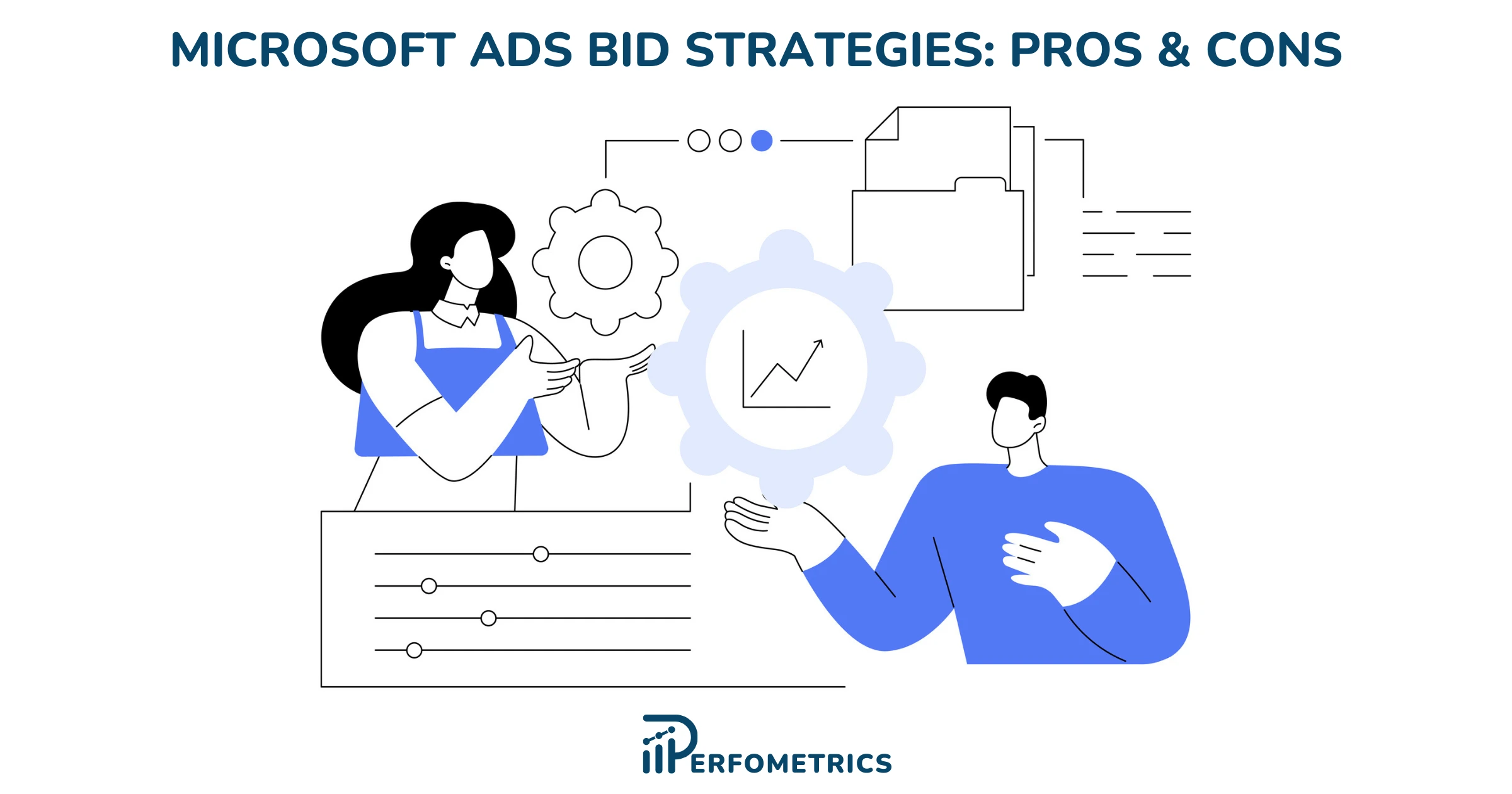Top 5 Pros and Cons of Bid Strategies in Microsoft Ads: Comprehensive Overview

In the ever-evolving landscape of digital advertising, Microsoft Ads offers a complete set of bid strategies, each with its unique advantages and potential drawbacks. From Cost per Completed View (CPCV) to Portfolio Bid Strategies, these strategies provide advertisers with the flexibility and control to meet their specific marketing goals.
The best strategy depends on your specific goals, target audience, and budget set in Microsoft Ads. Experiment with different strategies, analyze the results, and adjust your approach accordingly. For more, here are our best practices for every bid strategy in Microsoft Ads.
Pros and Cons of Cost per Completed View (CPCV) Bid Strategy
The Cost per Completed View (CPCV) bid strategy is a game-changer. It allows you to pay only when a viewer watches your video ad to completion, ensuring that your message is fully delivered.
Here are the advantages and disadvanatges of completed view (CPCV) bid strategy in Microsot Ads:
| Pros | Cons |
|---|---|
| 1. Pay only when the viewer watches the entire ad. | 1. May lead to fewer overall views. |
| 2. Ensures viewer engagement. | 2. Not suitable for longer ads. |
| 3. Ideal for brand awareness campaigns. | 3. May not guarantee conversions. |
| 4. Can lead to higher viewer retention. | 4. Requires compelling video content. |
| 5. Cost-effective for engaging ads. | 5. Not ideal for direct response campaigns. |
The CPCV bid strategy can be a powerful tool in your advertising arsenal, particularly for brand awareness campaigns. However, it’s essential to consider the potential drawbacks and ensure your video content is engaging enough to retain viewers until the end. Remember, the key to a successful ad campaign is choosing the right strategy that aligns with your goals.
Pros and Cons of Cost per Thousand Impressions (CPM) Bid Strategy
The Cost per Thousand Impressions (CPM) bid strategy is a popular choice among advertisers aiming to boost their brand visibility. With this strategy, you pay for every thousand impressions your ad receives.
Here are the advantages and potential challenges of using cost per thousand impressions (CPM) bid strategy in Microsot Ads:
| Pros | Cons |
|---|---|
| 1. Ideal for increasing brand exposure. | 1. Impressions do not equate to engagement. |
| 2. Cost-effective for high-traffic websites. | 2. May lead to lower click-through rates. |
| 3. Easy to measure and compare. | 3. Not ideal for conversion-focused campaigns. |
| 4. Good for targeting specific demographics. | 4. Requires high-quality creative to stand out. |
| 5. Can lead to higher brand recall. | 5. May not guarantee visibility. |
The CPM bid strategy can be an effective way to increase your brand’s visibility and recall. However, it’s crucial to remember that impressions do not necessarily translate into engagement or conversions. Therefore, this strategy should be used as part of a broader, multi-faceted advertising approach.
Pros and Cons of Cost per Sale (CPS) Bid Strategy
The Cost per Sale (CPS) bid strategy is a performance-based advertising model where you pay only when an ad leads to a sale. This strategy is particularly appealing to advertisers focused on return on investment (ROI).
Here are the pros and cons of cost per sale (CPS) bid strategy in Microsot Ads:
| Pros | Cons |
|---|---|
| 1. Pay only when a sale is made. | 1. Requires a well-optimized sales funnel. |
| 2. Directly tied to revenue. | 2. Higher risk if conversion rate is low. |
| 3. Ideal for ROI-focused campaigns. | 3. Not suitable for brand awareness campaigns. |
| 4. Can lead to higher profitability. | 4. Requires tracking and attribution setup. |
| 5. Encourages customer-centric advertising. | 5. May lead to higher costs per acquisition. |
The CPS bid strategy can be a powerful tool for advertisers focused on ROI, as it directly ties advertising costs to sales. However, it requires a well-optimized sales funnel and accurate tracking setup. As with any strategy, it’s crucial to consider your specific goals and circumstances.
Pros and Cons of Enhanced Cost per Click (eCPC) Bid Strategy
The Enhanced Cost per Click (ECPC) bid strategy is designed to optimize your bids automatically, helping you get more conversions while maintaining control over your keyword bids.
Here are the benefits and inconvinences of enhanced cost per click (eCPC) bid strategy in Microsot Ads:
| Pros | Cons |
|---|---|
| 1. Automatically adjusts bids for better performance. | 1. Requires conversion tracking setup. |
| 2. Maintains control over keyword bids. | 2. May lead to higher costs per click. |
| 3. Ideal for conversion-focused campaigns. | 3. Not suitable for brand awareness campaigns. |
| 4. Can lead to higher conversion rates. | 4. Performance depends on historical conversion data. |
| 5. Balances automation with control. | 5. May not be ideal for new or low-volume campaigns. |
The Enhanced CPC bid strategy can be a valuable tool for advertisers seeking to balance automation with control. By automatically adjusting your bids for better performance, it can help drive more conversions. However, it’s important to consider the potential drawbacks and ensure you have adequate conversion data for this strategy to work effectively.
Pros and Cons of Manual Cost per Click (Manual CPC) Bid Strategy
The Manual Cost per Click (CPC) bid strategy gives you full control over your keyword bids, allowing you to set the maximum amount that you’re willing to pay for each click on your ad.
Let’s examine the pros and cons of manual cost per click (Manual CPC) bid strategy in Microsot Ads:
| Pros | Cons |
|---|---|
| 1. Full control over keyword bids. | 1. Requires constant monitoring and adjustment. |
| 2. Ideal for advertisers with specific budget constraints. | 2. May miss out on potential conversions. |
| 3. Allows for strategic bidding on high-value keywords. | 3. Not ideal for large-scale campaigns. |
| 4. Can lead to cost-effective ad spend. | 4. Requires in-depth knowledge of keyword performance. |
| 5. Enables precise budget allocation. | 5. Time-consuming compared to automated strategies. |
The Manual CPC bid strategy can be an effective tool for advertisers who prefer to have full control over their keyword bids. However, it requires constant monitoring and adjustment, and may not be ideal for large-scale campaigns. As always, the best strategy depends on your specific goals and circumstances.
Pros and Cons of Manual Cost per Thousand Impressions (Manual CPM) Bid Strategy
The Manual Cost per Thousand Impressions (CPM) bid strategy allows you to set the maximum amount you’re willing to pay for a thousand impressions of your ad. This strategy gives you full control over your ad impressions.
Here are the pros and cons of manual cost per thousand impressions (Manual CPM) bid strategy in Microsot Ads:
| Pros | Cons |
|---|---|
| 1. Full control over impression bids. | 1. Requires constant monitoring and adjustment. |
| 2. Ideal for advertisers aiming for brand exposure. | 2. May not guarantee engagement or conversions. |
| 3. Allows for strategic bidding on high-traffic platforms. | 3. Not ideal for conversion-focused campaigns. |
| 4. Can lead to cost-effective ad spend. | 4. Requires in-depth knowledge of platform traffic. |
| 5. Enables precise budget allocation. | 5. Time-consuming compared to automated strategies. |
The Manual CPM bid strategy can be an effective tool for advertisers who prefer to have full control over their ad impressions. However, it requires constant monitoring and adjustment, and may not be ideal for campaigns focused on engagement or conversions. As always, the best strategy depends on your specific goals and circumstances.
Pros and Cons of Manual Cost per Completed View (Manual CPV) Bid Strategy
The Manual Cost per Completed View (CPV) bid strategy allows you to set the maximum amount you’re willing to pay when a viewer watches your video ad to completion. This strategy gives you full control over your ad views.
Let’s explore the pros and cons of manual cost per completed view (Manual CPV) bid strategy in Microsot Ads:
| Pros | Cons |
|---|---|
| 1. Full control over view bids. | 1. Requires constant monitoring and adjustment. |
| 2. Ideal for advertisers with engaging video content. | 2. May lead to fewer overall views. |
| 3. Allows for strategic bidding on high-engagement platforms. | 3. Not suitable for longer ads. |
| 4. Can lead to cost-effective ad spend. | 4. Requires compelling video content. |
| 5. Enables precise budget allocation. | 5. Time-consuming compared to automated strategies. |
The Manual CPV bid strategy can be an effective tool for advertisers who prefer to have full control over their ad views. However, it requires constant monitoring and adjustment, and may not be ideal for campaigns with longer ads. As always, the best strategy depends on your specific goals and circumstances.
Pros and Cons of Target Impression Share Bid Strategy
The Target Impression Share bid strategy is designed to maximize your ad’s visibility by aiming to show your ad on a certain percentage of eligible impressions. This strategy gives you control over your ad’s impression share.
These are the advantages and disadvanatges of target impression share bid strategy in Microsot Ads:
| Pros | Cons |
|---|---|
| 1. Maximizes ad visibility. | 1. May lead to higher costs per click. |
| 2. Ideal for advertisers aiming for brand exposure. | 2. Does not guarantee engagement or conversions. |
| 3. Allows for strategic bidding on high-traffic platforms. | 3. Requires constant monitoring and adjustment. |
| 4. Can lead to higher brand recall. | 4. Not ideal for conversion-focused campaigns. |
| 5. Enables precise control over impression share. | 5. May not be suitable for niche markets. |
The Target Impression Share bid strategy can be an effective tool for advertisers seeking to maximize their ad’s visibility. However, it requires constant monitoring and adjustment, and may not be ideal for campaigns focused on engagement or conversions. As always, the best strategy depends on your specific goals and circumstances.
Pros and Cons of Maximize Clicks Bid Strategy
The Maximize Clicks bid strategy is an automated bid strategy that sets your bids to help get as many clicks as possible within your budget. This strategy is particularly useful for advertisers who want to drive traffic to their website.
Let’s explore the pros and cons of maximize clicks bid strategy in Microsot Ads:
| Pros | Cons |
|---|---|
| 1. Maximizes the number of ad clicks. | 1. May lead to higher costs per click. |
| 2. Ideal for driving traffic to your website. | 2. Does not guarantee conversions. |
| 3. Automated bidding saves time. | 3. Requires a well-defined budget. |
| 4. Can lead to increased website engagement. | 4. Not ideal for conversion-focused campaigns. |
| 5. Simplifies bid management. | 5. Less control over individual keyword bids. |
The Maximize Clicks bid strategy can be a powerful tool for advertisers seeking to drive traffic to their website. However, it’s important to remember that more clicks do not necessarily translate into more conversions. Therefore, this strategy should be used as part of a broader, multi-faceted advertising approach.
Pros and Cons of Maximize Conversions Bid Strategy
The Maximize Conversions bid strategy is an automated bid strategy that sets your bids to help get as many conversions as possible within your budget. This strategy is particularly useful for advertisers who want to drive conversions on their website.
Here are the benefits and inconvinences of maximize conversions bid strategy in Microsoft Ads:
| Pros | Cons |
|---|---|
| 1. Maximizes the number of ad conversions. | 1. May lead to higher costs per click. |
| 2. Ideal for conversion-focused campaigns. | 2. Requires conversion tracking setup. |
| 3. Automated bidding saves time. | 3. Requires a well-defined budget. |
| 4. Can lead to increased ROI. | 4. Less control over individual keyword bids. |
| 5. Simplifies bid management. | 5. Not ideal for brand awareness campaigns. |
The Maximize Conversions bid strategy can be a powerful tool for advertisers seeking to drive conversions on their website. However, it’s important to remember that more conversions do not necessarily translate into higher ROI. Therefore, this strategy should be used as part of a broader, multi-faceted advertising approach.
Pros and Cons of Target Cost per Action (tCPA) Bid Strategy
The Target CPA bid strategy is an automated bid strategy that sets your bids to help get as many conversions as possible at your target cost per acquisition. This strategy is particularly useful for advertisers who have a specific acquisition cost goal.
Here are the pros and cons of target cost per action (tCPA) bid strategy in Microsot Ads:
| Pros | Cons |
|---|---|
| 1. Maximizes the number of conversions at your target CPA. | 1. May lead to fewer clicks if target CPA is set too low. |
| 2. Ideal for conversion-focused campaigns with specific CPA goals. | 2. Requires conversion tracking setup. |
| 3. Automated bidding saves time. | 3. Requires a well-defined budget. |
| 4. Can lead to increased ROI. | 4. Less control over individual keyword bids. |
| 5. Simplifies bid management. | 5. Not ideal for brand awareness campaigns. |
The Target CPA bid strategy can be a powerful tool for advertisers seeking to drive conversions at a specific cost. However, it’s important to remember that setting your target CPA too low may result in fewer clicks and conversions. Therefore, this strategy should be used as part of a broader, multi-faceted advertising approach.
Pros and Cons of Target Return on Ad Spend (tROAS) Bid Strategy
The Target ROAS bid strategy is an automated bid strategy that sets your bids to achieve an average return on ad spend (ROAS) equal to your target. This strategy is particularly useful for advertisers who have a specific return on ad spend goal.
These are the pros and cons of target return on ad spend (tROAS) bid strategy in Microsot Ads:
| Pros | Cons |
|---|---|
| 1. Maximizes the return on ad spend. | 1. May lead to fewer conversions if target ROAS is set too high. |
| 2. Ideal for ROI-focused campaigns with specific ROAS goals. | 2. Requires conversion value tracking setup. |
| 3. Automated bidding saves time. | 3. Requires a well-defined budget. |
| 4. Can lead to increased profitability. | 4. Less control over individual keyword bids. |
| 5. Simplifies bid management. | 5. Not ideal for brand awareness campaigns. |
The Target ROAS bid strategy can be a powerful tool for advertisers seeking to maximize their return on ad spend. However, it’s important to remember that setting your target ROAS too high may result in fewer conversions. Therefore, this strategy should be used as part of a broader, multi-faceted advertising approach.
Pros and Cons of Portfolio Bid Strategies
Portfolio Bid Strategies allow you to group multiple campaigns together and apply a single shared bid strategy across them. This strategy is particularly useful for advertisers who want to manage their bids across multiple campaigns efficiently.
Let’s explore the benefits and inconvinences of portfolio bid strategies in Microsot Ads:
| Pros | Cons |
|---|---|
| 1. Efficient management of multiple campaigns. | 1. May lead to uneven performance across campaigns. |
| 2. Ideal for advertisers with multiple campaigns sharing a common goal. | 2. Requires careful grouping of campaigns. |
| 3. Allows for strategic bidding across campaigns. | 3. Not ideal for campaigns with unique goals. |
| 4. Can lead to cost-effective ad spend. | 4. Less control over individual campaign bids. |
| 5. Simplifies bid management. | 5. Time-consuming setup compared to individual strategies. |
Portfolio Bid Strategies can be a powerful tool for advertisers seeking to manage multiple campaigns efficiently. However, it’s important to remember that this strategy requires careful grouping of campaigns and may result in uneven performance across campaigns. Therefore, this strategy should be used as part of a broader, multi-faceted advertising approach.
Final Thoughts
Choosing the right bid strategy in Microsoft Ads can significantly impact the success of your advertising campaigns. While some strategies may maximize visibility, others focus on conversions or return on ad spend.
- Cost per Completed View (CPCV): Ideal for brand awareness campaigns with engaging video content.
- Cost per Thousand Impressions (CPM): Best for increasing brand exposure, especially on high-traffic websites.
- Cost per Sale (CPS): Perfect for ROI-focused campaigns with a well-optimized sales funnel.
- Enhanced CPC: Balances automation with control, ideal for conversion-focused campaigns.
- Manual CPC: Gives full control over keyword bids, suitable for advertisers with specific budget constraints.
- Manual CPM: Allows full control over impression bids, ideal for brand exposure.
- Manual CPV: Offers full control over view bids, best for campaigns with engaging video content.
- Target Impression Share: Maximizes ad visibility, perfect for campaigns aiming for brand exposure.
- Maximize Clicks: An automated strategy to get as many clicks as possible within your budget.
- Maximize Conversions: Ideal for conversion-focused campaigns, automatically sets bids to get as many conversions as possible within your budget.
- Target CPA: Aims to get as many conversions as possible at your target cost per acquisition.
- Target ROAS: Sets bids to achieve an average return on ad spend equal to your target.
- Portfolio Bid Strategies: Efficiently manages multiple campaigns that share a common goal.
Understanding the pros and cons of each strategy is crucial in aligning your advertising efforts with your marketing goals.



